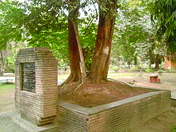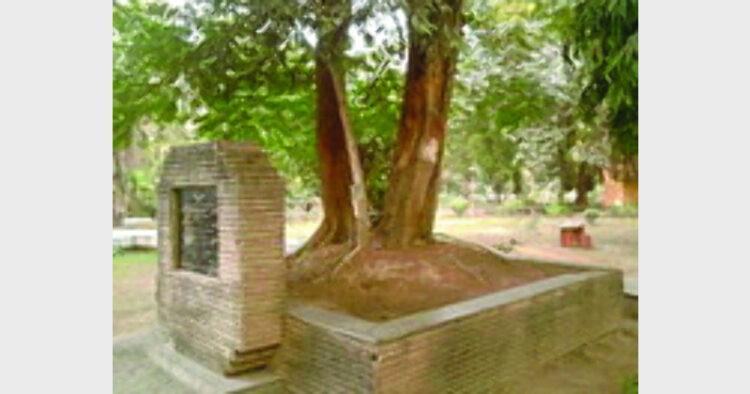 Children , the liberties we enjoy in Independent Bharat have not come to us on a platter. A lot of sacrifices were made by our countrymen to achieve this. And now we have got so inclined towards the western culture that we don’t find it necessary to remember the contribution made by the shinning stars of Bharat. Chandra Shekhar was one of such star whose death anniversary falls on February 27.
Children , the liberties we enjoy in Independent Bharat have not come to us on a platter. A lot of sacrifices were made by our countrymen to achieve this. And now we have got so inclined towards the western culture that we don’t find it necessary to remember the contribution made by the shinning stars of Bharat. Chandra Shekhar was one of such star whose death anniversary falls on February 27.
Popularly known asAzad(“The Liberated”), Chandra Shekhar Azad was anIndianrevolutionary who reorganised theHindustan Republican Associationunder the new name ofHindustan Socialist Republican Association(HSRA) after the death of its founder,Ram Prasad Bismil.
Early life
Chandra Shekhar was born on 23 July 1906 in village Bhavra in Jhabua district of Madhya Pradesh to Pandit Sita Ram Tiwari and Jagrani Devi. He received his early education in Bhavra.
Just like any other parents his mother wanted her son to be a great Sanskritscholar and persuaded his father to send him to Kashi Vidyapeeth,Banarasto study. In December 1921, when Gandhiji launched theNon-Cooperation Movement, Chandra Shekhar, then a 15-year old student, was so facinated by it that he joined it. When arrested and produced before the magistrate, instead of telling his true name, i.e. Chandra Shekhar Tiwari he gave his name as ‘Azad’, his father’s name as ‘Swatantra’ and his residence as ‘prison’. The provoked magistrate sentenced him to fifteen lashes of flogging and sentenced him to fifteen day imprisonment.
Revolutionary life
After withdrawal of the Non-Cooperation Movement in 1922, Azad was attracted towards revolutionary activities. He joined the Hindustan Socialist Republican Army (HSRA) and believed that India’s future lay in socialism. He met a young revolutionary, Pranvesh Chatterji, who introduced him to Ram Prasad Bismil who had formed the Hindustan Republican Association (HRA), a revolutionary organisation. Azad was impressed with the aim of HRA, i.e., an Independent India with equal rights and opportunity to everyone without discrimination of caste, creed, religion or social status. On introduction, Bismil was impressed by Azad, when Azad reportedly put his hand over a lamp and did not remove it till his skin burnt. He then became an active member of the HRA. Most of his revolutionary activities were against the British Government and were planned and executed from Shahjahanpur which was also the hometown of Ram Prasad .He was involved in numerous such activities like the Kakori Train Robbery (1926), the attempt to blowup the Viceroy’s train(1926) and the shooting of John Poyantz Saunders at Lahore (1928) to avenge the killing of Lala Lajpat Rai. Despite being a member of Congress,Motilal Nehruregularly gave funds in support of the cause for which Azad was fighting.
Activities in Jhansi
Azad madeJhansihis organisation’s hub for some time. He used the forest ofOrchha, situated 15 kilometres from Jhansi, as a site for shooting practice and, being an expert marksman, he trained other members of his group. Near the forest he built a hut near to a HanumanTemple on the banks of theSatar River. He lived there under the alias of Pandit Harishankar Brahmachari for a long period, and started teaching children from the nearby village of Dhimarpura. In this way he managed to establish good rapport with the local residents. The village Dhimarpura was renamed as Azadpura by theMadhya Pradesh Government.
While living in Jhansi, he also learned to drive a car at Bundelkhand Motor Garage inSadar Bazar. Sadashivrao Malkapurkar, Vishwanath Vaishampayan and Bhagwan Das Mahaur came in close contact with him and became an integral part of his revolutionary group.
With Bhagat Singh
In the aftermath of theKakori train robberyin 1925, the British clamped down on revolutionary activities. Prasad, Ashfaqulla Khan,Thakur Roshan SinghandRajendra Nath Lahiriwere sentenced to death for their participation. Azad,Keshab ChakravarthyandMurari Sharmaevaded capture. Chandra Shekhar Azad later reorganised the HRA with the help of revolutionaries like Sheo Verma and Mahaveer Singh. Azad was also a close associate ofBhagwati Charan Vohrawho along withBhagat Singh,Sukhdev, andRajguru, helped him to transform the HRA into the HSRA in 1928 so as to achieve their primary aim of an Independent India based on socialist principle.
Death
In the last week of February 1931, Azad went to Allahabad where on 27 February 1931 he went to Alfred Park ( now called Chandrashekhar Azad Park) to meet a revolutionary colleague, Sukhdev Raj. The police was notified of his location by an informer. Faced with armed police, Azad fired upon them. He was wounded in the process of killing three policemen and wounding some others. His actions made it possible for Sukhdev Raj to escape. After a long shootout, holding true to his pledge to never be captured alive, he shot himself dead with the last bullet of his pistol. The Colt Pistol of Chandra Shekhar Azad is displayed at theAllahabad Museum
The body was sent to Rasulabad Ghat for cremation without informing general public. As it came to light, people surrounded the park where the incident had taken place. They made slogans against the British rule and grieved the death of a true son of the soil, Azad.
— Aniket Raja













Comments